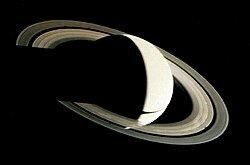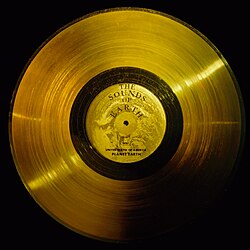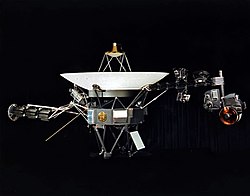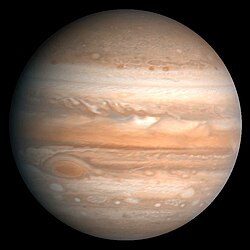Family portrait (Voyager 1)
Autor/Urheber:
NASA, Voyager 1
Größe:
4000 x 1200 Pixel (702224 Bytes)
Beschreibung:
Original Caption Released with Image: The cameras of Voyager 1 on Feb. 14, 1990, pointed back toward the sun and took a series of pictures of the sun and the planets, making the first ever "portrait" of our solar system as seen from the outside. In the course of taking this mosaic consisting of a total of 60 frames, Voyager 1 made several images of the inner solar system from a distance of approximately 4 billion miles (6.4 billion kilometers) and about 32 degrees above the ecliptic plane. Thirty-nine wide angle frames link together six of the planets of our solar system in this mosaic. Outermost Neptune is 30 times further from the sun than Earth. Our sun is seen as the bright object in the center of the circle of frames. The wide-angle image of the sun was taken with the camera's darkest filter (a methane absorption band) and the shortest possible exposure (1/125 second) to avoid saturating the camera's vidicon tube with scattered sunlight. The sun is not large as seen from Voyager, only about one-fortieth of the diameter as seen from Earth, but is still almost 8 million times brighter than the brightest star in Earth's sky, Sirius. The result of this great brightness is an image with multiple reflections from the optics in the camera. Wide-angle images surrounding the sun also show many artifacts attributable to scattered light in the optics. These were taken through the clear filter with one second exposures. The insets show the planets magnified many times. Narrow-angle images of Earth, Venus, Jupiter, Saturn, Uranus and Neptune were acquired as the spacecraft built the wide-angle mosaic. Jupiter is larger than a narrow-angle pixel and is clearly resolved, as is Saturn with its rings. Uranus and Neptune appear larger than they really are because of image smear due to spacecraft motion during the long (15 second) exposures. From Voyager's great distance Earth and Venus are mere points of light, less than the size of a picture element even in the narrow-angle camera. Earth was a crescent only 0.12 pixel in size. Coincidentally, Earth lies right in the center of one of the scattered light rays resulting from taking the image so close to the sun.
Weitere Informationen zur Lizenz des Bildes finden Sie hier. Letzte Aktualisierung: Sat, 23 Mar 2024 21:51:19 GMT
Relevante Bilder
Relevante Artikel
Carl Sagan
Carl Edward Sagan war ein US-amerikanischer Astronom, Astrophysiker, Exobiologe, Fernsehmoderator, Sachbuchautor und Schriftsteller.
.. weiterlesen
Voyager 1
Voyager 1 ist eine Raumsonde der US-amerikanischen Raumfahrtbehörde NASA zur Erforschung des äußeren Planetensystems und des interstellaren Raums im Rahmen des Voyager-Programms. Sie wurde am 5. September 1977 vom Space Launch Complex 41 auf Cape Canaveral mit einer Titan-IIIE-Centaur-Rakete gestartet. Ihre identisch aufgebaute Schwestersonde Voyager 2 war bereits 16 Tage früher auf einer anderen Flugbahn gestartet. Voyager 1 flog zunächst die Planeten Jupiter und Saturn an und trat am 25. August 2012 als erstes von Menschen geschaffenes Objekt in den interstellaren Raum ein.
.. weiterlesen
Pale Blue Dot
Pale Blue Dot ist der Name eines Fotos der Erde, welches auf Anregung des US-amerikanischen Astronomen Carl Sagan von der Raumsonde Voyager 1 aus einer Entfernung von etwa 6 Milliarden Kilometer oder 40,5 AE aufgenommen wurde. Es handelt sich bis heute um das aus dem größten Abstand gemachte Foto der Erde. Zudem war es zum damaligen Zeitpunkt die größte Distanz zur Erde, aus der jemals ein Foto aufgenommen wurde.
.. weiterlesen






































